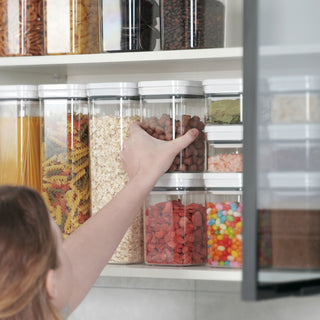Struggling with a chaotic kitchen? Buried under an avalanche of mismatched lids and containers every time you open your cupboard? You're not alone. Organizing food storage containers is a common headache for many. But fear not! This post will guide you through simple, effective steps to declutter your kitchen and make finding the right container a breeze. Say goodbye to kitchen chaos and hello to a neatly organized space!
Start with a Clean Slate
First things first: empty all your cabinets and drawers that hold food storage containers. It's time to take stock of what you have. This is your chance to declutter and decide which containers are worth keeping. Say goodbye to any that are missing lids, are damaged, or you simply never use. Remember, less is more when it comes to easy organization.
Match Lids to Containers
Once you've pared down your collection, the next step is to match all lids to their corresponding containers. This may seem like a no-brainer, but you'll be surprised at how many orphan lids and containers you may find. Making sure everything has its match is key to maintaining an organized kitchen.
Choose a Storage Method
Now that you have a clear inventory, decide how you want to store your containers. There are a couple of popular methods:
- Nesting by Size: This method saves space by nesting smaller containers inside larger ones. Keep lids on the side or in a separate container for easy access.
- Storing with Lids On: If space allows, storing containers with their lids on can save time and prevent the dreaded lid hunt. This method works well for those with a larger kitchen space.
Implement Organizational Tools
Consider using organizational tools to keep your containers in check. Drawer dividers, shelves, and baskets can all play a role in keeping your kitchen tidy. Clear labeling can also be a game-changer, especially for containers used for specific purposes.
Maintain the System
The key to keeping your kitchen organized is maintenance. Make it a habit to return containers to their rightful place after washing. Every few months, do a quick inventory to ensure everything is still in order and declutter as needed.
FAQs Related to Food Storage Containers Organization
What should I do with mismatched lids and containers?
First, try to find a match for every container and lid. If you're left with unmatched items, consider recycling them if possible. Some containers can be repurposed for other uses around the home, such as organizing office supplies or small tools. If they're not useful to you, check if your local recycling program accepts them.
How often should I declutter my food storage containers?
It's a good idea to go through your food storage containers every 6 to 12 months. This helps keep your collection manageable and ensures you're only keeping containers that are in good condition and frequently used. Seasonal changes or major grocery shopping trips can also be good prompts for a quick inventory check.
Are there any tips for storing large sets of food storage containers?
For large sets, consider using a dedicated cabinet or shelf where each container and lid can be stored upright, similar to filing papers. This setup allows you to easily see and grab what you need without disrupting the rest of the collection. If space is limited, using a large container to hold all lids categorized by size or shape can also be an effective strategy.
How can I prevent my food storage containers from smelling?
To prevent odors, make sure to clean containers and lids thoroughly after each use. Baking soda or a mixture of vinegar and water can help remove stubborn smells. Letting them air dry completely before storing is also crucial to prevent mold and mildew growth. For containers that seem to retain odors, storing them with a pinch of salt or a piece of charcoal inside can help absorb lingering smells.
Can stacking containers damage them over time?
Stacking containers, especially when they're made of plastic, can sometimes lead to warping or cracking, particularly if heavy items are placed on top. To avoid damage, nest containers by size without pressing them too tightly together. Storing heavier items at the bottom of your cabinet or shelf and lighter ones on top can also help maintain the integrity of your containers.
What's the best way to label food storage containers for easy identification?
Using waterproof, removable labels is a great way to keep track of what's inside your containers, especially for items stored in the freezer or refrigerator. You can write the contents and the date it was stored on the label. For a more high-tech solution, consider using erasable labels or markers to easily update the information as needed. This practice is particularly useful for meal prepping and avoiding food waste.
How do I choose the right size of container for food storage?
Selecting the right size container depends on the amount of food you need to store. A good rule of thumb is to choose a container that can be filled to at least three-quarters of its capacity. This minimizes the air space around the food, which can help preserve its freshness. For bulk items or larger meals, opt for larger containers, but remember to consider your available storage space and how you plan to use the leftovers.
Is it better to use glass or plastic containers for food storage?
Both glass and plastic containers have their advantages. Glass is durable, doesn't absorb odors or stains, and can go from freezer to microwave to dishwasher without issues. However, it's heavier and can break more easily than plastic. Plastic containers are lightweight and less fragile, but they can stain and retain odors over time. Some plastics can also degrade with repeated use, especially when heated. Consider your lifestyle, storage needs, and environmental impact when choosing between glass and plastic.

